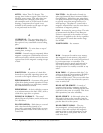
Glossary
G-2 Quickview 300 80/100/120/160/200/250/300GB PATA
BPI – Abbreviation for bits per inch. A
measure of how densely information is packed
on a storage medium. Flux changes per inch is
also a term commonly used in describing
storage density on a magnetic surface.
BUFFER – An area of RAM reserved for
temporary storage of data that is waiting to be
sent to a device that is not yet ready to receive
it. The data is usually on its way to or from the
disk drive or some other peripheral device.
BUS – The part of a chip, circuit board, or
interface designed to send and receive data.
BYTE – The basic unit of computer
memory, large enough to hold one character
of alphanumeric data. Comprised of eight bits.
See also bit.
C
CACHE – Random-access memory used as a
buffer between the CPU and a hard disk.
Information more likely to be read or changed
is placed in the cache, where it can be accessed
more quickly to speed up general data flow.
CAPACITY – The amount of information
that can be stored on a disk drive. The data is
stored in bytes, and capacity is usually
expressed in megabytes.
CDB – Command Descriptor Block. The
SCSI structure used to communicate requests
from an initiator (system) to a target (drive).
CLEAN ROOM – An environmentally
controlled dust-free assembly or repair facility
in which hard disk drives are assembled or can
be opened for internal servicing.
CLUSTER – A group of sectors on a disk
drive that is addressed as one logical unit by
the operating system.
CONTROLLER – Short form of disk
controller. The chip or complete circuit that
translates computer data and commands into a
form suitable for use by the disk drive.
CONTROLLER CARD – An adapter
holding the control electronics for one or
more hard disks, usually installed in a slot in
the computer.
CPU – Acronym for Central Processing Unit.
The microprocessor chip that performs the
bulk of data processing in a computer.
CRC – Acronym for Cyclic Redundancy Check.
An error detection code that is recorded
within each sector and is used to see whether
parts of a string of data are missing or
erroneous.
CYLINDER – On a disk drive that has more
than one recording surface and heads that
move to various tracks, the group of all tracks
located at a given head position. The number
of cylinders times the number of heads equals
the number of tracks per drive.
D
DATA SEPARATOR – On a disk drive
that stores data and timing information in an
encoded form, the circuit that extracts the
data from the combined data and clock signal.
DEDICATED SERVO – A surface separate
from the surface used for data that contains
only disk timing and positioning information
and contains no data.
DEFECT MANAGEMENT – A method
that is implemented to ensure long term data
integrity. Defect management eliminates the
need for user defect maps. This is
accomplished by scanning the disk drives at
the factory for defective sectors. Defective
sectors are deallocated prior to shipment. In
addition, during regular use, the drive
continues to scan and compensate for any new
defective sectors on the disk.
DISK – In general, any circular-shaped
data-storage medium that stores data on the
flat surface of the platter. The most common
type of disk is the magnetic disk, which stores
data as magnetic patterns in a metal or
metal-oxide coating. Magnetic disks come in
two forms: floppy and hard. Optical recording
is a newer disk technology that gives higher
capacity storage but at slower access times.


















